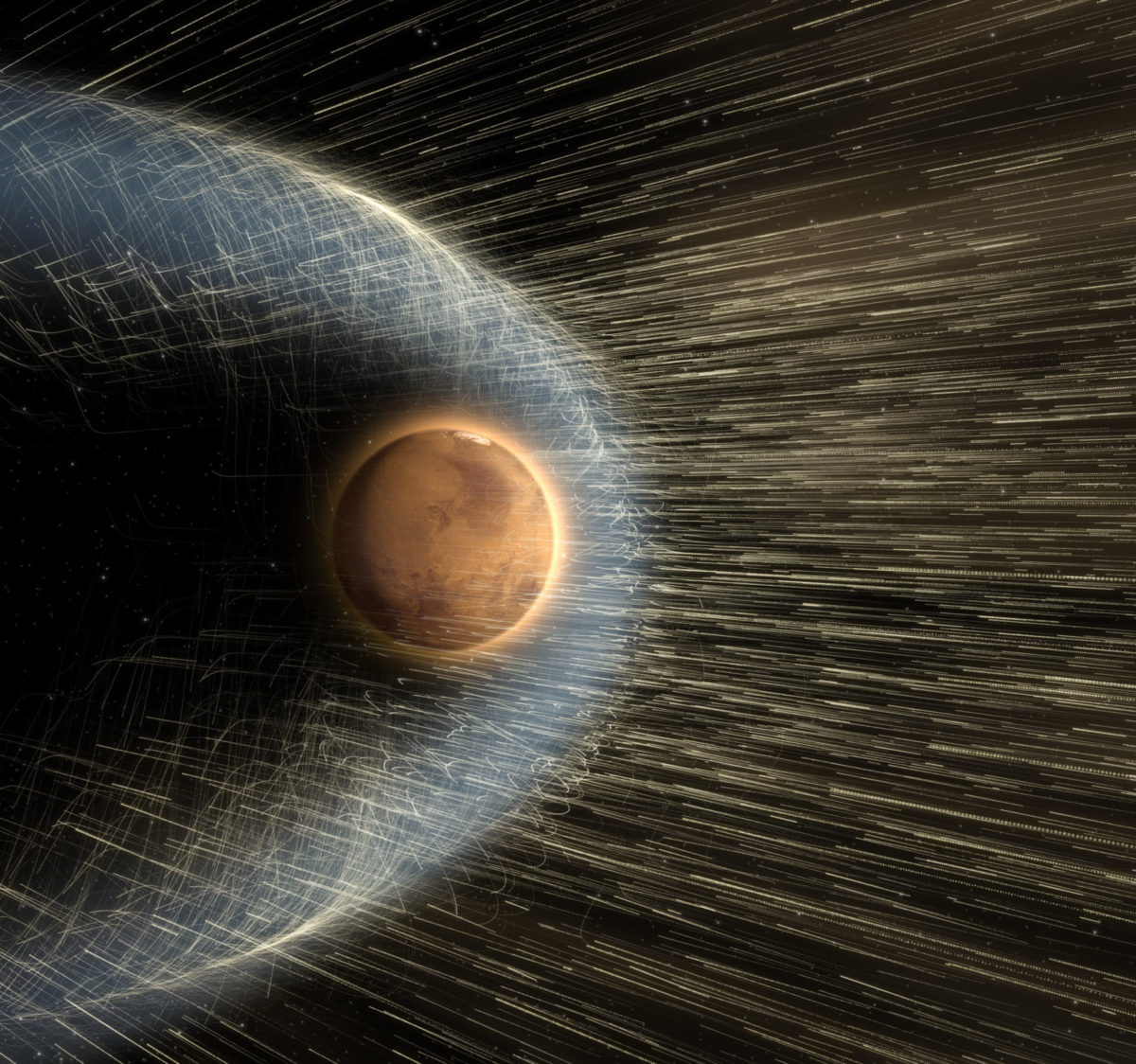MAVEN, studying how Mars lost its atmosphere
Highlights
- NASA's Mars Atmosphere and Volatile Evolution spacecraft, MAVEN, is an orbiter dedicated to studying Mars’ atmosphere.
- MAVEN launched in November 2013 and arrived at Mars in September 2014.
- MAVEN is revealing how Mars loses its atmosphere to space and providing clues on how and when the planet lost its water. The orbiter also relays communications between surface missions and Earth.
About Mars' atmosphere
Earth’s magnetic field protects us from the Sun, funneling harmful high-energy particles away from the planet that would otherwise strip our atmosphere away. Mars doesn’t have a magnetic field, so solar radiation strikes its atmosphere directly, knocking atoms off into space. This is how scientists think Mars turned from a warm, wet planet into a chilly, dry desert world roughly 3 billion years ago.
Liquid water, essential for life as we know it, once flowed freely on Mars, evident in features resembling dry riverbeds and minerals that only form in the presence of liquid water. Without much of an atmosphere, Mars' surface water evaporated. NASA's MAVEN spacecraft is studying Mars’ atmosphere to help us understand exactly what happened. This gives us clues about possible past life there, and what planetary processes make Earth a haven for life.
What is MAVEN?
MAVEN is part of NASA's Mars Exploration Program, an unprecedented, multi-decade campaign to comprehensively understand Mars and its suitability to host past or present life. Within just weeks of arriving at Mars, MAVEN observed oxygen, carbon and hydrogen escaping from the planet’s atmosphere into space. These atoms were once part of carbon dioxide and water vapor molecules near the surface.
MAVEN found that Mars’ atmospheric loss is primarily driven by the Sun. The Sun emits a stream of hot, highly energetic particles collectively known as the solar wind. When this solar wind hits the unprotected Martian atmosphere, it imparts energy to atmospheric atoms and molecules, giving them enough velocity to escape the planet's gravity. MAVEN learned that the solar wind penetrates more deeply into Mars’ atmosphere than previously thought.
Because of its egg-shaped orbit, Mars is closer to the Sun at some points than others. MAVEN discovered that Mars lost 10 times more hydrogen at the nearest points than at its farthest, mostly due to increased sunlight and solar wind.
MAVEN's past, present and future
MAVEN launched in November 2013 and arrived at Mars in September 2014. One of its flagship instruments is the Imaging UltraViolet Spectrograph, or IUVS, a camera able to see ultraviolet light. This helps MAVEN measure gases leaving Mars’ atmosphere since they reflect and scatter ultraviolet light.
MAVEN created a global wind map of the planet’s upper atmosphere — a first for any planet other than Earth. It has also watched huge clouds spanning hundreds of kilometers form in a matter of hours.
MAVEN currently operates in an extended mission, continuing to observe and study changes in the Martian atmosphere. It also acts as a high-speed communications relay between surface spacecraft and Earth, allowing us to get more science data back from other Mars missions.

About MAVEN's observations
MAVEN detects solar wind entering Mars’ upper atmosphere using a mass spectrometer, a device that determines the elemental makeup of materials passing through it. A magnetometer on the spacecraft measures the electrical charge created when the solar wind hits atmospheric particles, which creates a weak magnetic field that accelerates the particles away from the planet. By tracking Mars' atmosphere over time, MAVEN has shown for the first time how exactly Mars loses its atmosphere and at what rate.
Auroras on Earth are caused by energetic charged particles from space crashing down into the atmosphere along Earth’s magnetic field lines, causing gases to glow near the poles. Since Mars has no internally generated magnetic field, the solar wind penetrates deeper and causes planet-wide auroras that have been observed by MAVEN.
In 2019, mission operators lowered MAVEN’s orbit so that it can relay data between Earth and NASA’s Perseverance rover. MAVEN has enough fuel to be operational until at least 2030, so it will be increasingly tasked with replacing communication relay responsibilities of aging orbiters like NASA's Mars Reconnaissance Orbiter and Odyssey spacecraft. While not conducting relay communications, MAVEN will continue to study Mars’s atmosphere.

Support missions like MAVEN
Whether it's advocating, teaching, inspiring, or learning, you can do something for space, right now. Let's get to work.
Acknowledgments: This page was originally authored by Jatan Mehta.


 Explore Worlds
Explore Worlds Find Life
Find Life Defend Earth
Defend Earth


